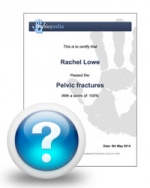Spurling's Test
Original Editor - Shanae Gordon
Top Contributors - Admin, Shanae Gordon, Scott Buxton, Rachael Lowe, Uchechukwu Chukwuemeka, Kim Jackson, WikiSysop, Evan Thomas, Naomi O'Reilly, Tarina van der Stockt, Kai A. Sigel, Tony Lowe, Eric Robertson and Dan Rhon
Purpose
[edit | edit source]
The Spurling's test (also known as Maximal Cervical Compression Test and Framonial Compression Test) is used during a musculoskeletal assessment of the cervical spine when looking for cervical nerve root compression causing Cervical Radiculopathy[1].
Technique[edit | edit source]
The patient is seated comfortably while physiotherapist stands behind the patient. The physiotherapist then interlocks their fingers and rests the volar aspect of both hands on top of the patient's head. The therapist then laterally flexes the patient's neck 30 degrees to the affected side and then applies a downward axial compression ensure not to laterally flex the patient's neck any further.[1]
Positive: when the pain arising in the neck radiates in the direction of the corresponding dermatome ipsilaterally
In some resources there is reference to test A and B, these variations are both used to assess for radiculopathy.
| [2] |
[3] |
This video shows a good demonstration of Spurling's test plus other assessment techniques for cervical radiculopathy
Evidence[edit | edit source]
When performing an assessment it is important to know if the tool you are using is measuring what you want to measure Specificity and how good it is correctly identifying a pattern Sensitivity[5] both contribute to the diagnostic accuracy of the test.
Diagnostic Accuracy[6][edit | edit source]
Sensitivity= .50
Specificity= .88
-LR = .58
+LR= 3.5
Reliability[6][edit | edit source]
Kappa= .60
Additional Information[edit | edit source]
Although this test is commonly used for assessing cervical radiculopathy it is important due to its lower sensitivity that other tests are used in conjuction. In 2003, Dr. Robert Wainner and colleagues examined the accuracy of the clinical examination and developed a clinical prediction rule to aid in the diagnosis of cervical radiculopathy. Their research demonstrated that 4 clinical tests, when combined, hold high diagnostic accuracy compared to EMG studies:
- Spurling's Test
- Upper limb tension 1
- Distraction test
- Cervical Rotation Test
When all 4 of these clinical features are present, the post-test probablity of cervical radiculopathy is 90%, if only three of the four test are positive the probability decrease to 65% [7][8].
Additional Resources[edit | edit source]
De Hertogh WJ; Vaes PH; Vijverman V; De Cordt A; Duquet W; The clinical examination of neck pain patients: The validity of a group of tests. Manual Therapy, 2007 Feb; 12 (1): 50-5.
Tong HC, Haig AJ, Yamakawa K. The Spurling test and cervical radiculopathy. Spine. 2002:27(2):156-9.
Rubinstein SM, Pool JJ, van Tulder MW, Riphagen II, de Vet HC. A systematic review of the diagnostic accuracy of provocative tests of the neck for diagnosing cervical radiculopathy. Eur Spine J. 2007: 16: 307-319.
Shah KC, Rajshekhar V. Reliability of diagnosis of soft cervical disc prolapse using Spurling's test. British Journal of Neurosurgery. 2004: 18(5): 480-483.
Rubinstein SM, Pool JJ, van Tulder MW, Riphagen II, de Vet HC. A systematic review of the diagnostic accuracy of provocative tests of the neck for diagnosing cervical radiculopathy. Eur Spine J. 2007: 16: 307-319.
Shah KC, Rajshekhar V. Reliability of diagnosis of soft cervical disc prolapse using Spurling's test. British Journal of Neurosurgery. 2004: 18(5): 480-483.
Recent Related Research (from Pubmed)[edit | edit source]
Failed to load RSS feed from http://www.ncbi.nlm.nih.gov/entrez/eutils/erss.cgi?rss_guid=1jQKP8USaQ9dT: Error parsing XML for RSS
Read 4 Credit[edit | edit source]
|
Would you like to earn certification to prove your knowledge on this topic? All you need to do is pass the quiz relating to this page in the Physiopedia member area. |
References[edit | edit source]
- ↑ 1.0 1.1 Konin JG, Wiksten DL, Isear JA, Brader H. Special Tests for Orthopedic Examination. Thorofare: SLACK Incorporated; 2006.
- ↑ Clinically Relevant Technologies, http://www.youtube.com/watch?v=zBR6M8gCajg, last accessed May 2011
- ↑ Clinically Relevant Technologies, http://www.youtube.com/watch?v=9dBBwTbCCls, last accessed May 2011
- ↑ Online Video, http://www.youtube.com/watch?v=YwR9EcKN_Jc, last accessed on 6/4/09
- ↑ Lalkhen A. McCluskey A. Clinical tests: sensitivity and specificity. Contin Educ Anaesth Crit Care Pain (2008) 8 (6): 221-223.
- ↑ 6.0 6.1 Flynn TW, Cleland JA, Whitman JM. Users' Guide to the Musculoskeletal Examination. Buckner: Evidence in Motion; 2008.
- ↑ Wainner et al. Reliability and diagnostic accuracy of the clinical examination and patient self-report measures for cervical radiculopathy. Spine 2003 Jan 1. 28(1):52-62
- ↑ Sidney M. Rubinstein et al. A systematic review of the diagnostic accuracy of provocative tests of the neck for diagnosing cervical radiculopathy. European Spine Journal. Volume 16, Number 3, 307-319







